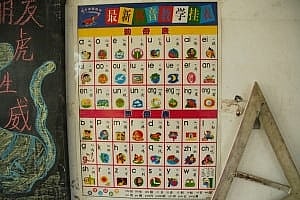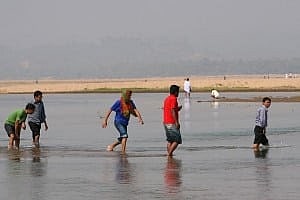10 Ways Schools Differ Around the World

We think of going to school as a universal experience, but it varies greatly depending on where in the world you are.
Setting aside the tragedy of the millions who are still denied any form of education, what schooling means and what it’s for depends a whole lot on a country’s history and culture. Some might say that the purpose of education is learning valuable facts. Others would argue it’s primarily about becoming an effective critical thinker. Others still see it as a process for creating the citizens and workers of the future. Most of us, of course, believe it to be some combination of the three – but which country you live in is a significant factor in determining which of the three will take priority.
There are less fundamental differences too – in the shape of the school year, the number of hours students are expected to work for, and how much of their lives their school is expected to be involved in. We’ve taken a look at the school systems in ten different countries around the world – here’s what you should know about them.
1. Chinese education emphasises memorisation and learning by drill
Of the different beliefs about what education is for, Chinese schools lean very strongly towards the memorisation and retention of facts. This is demonstrated in the gaokao, the university admissions exam, which depends on what a student can memorise and repeat; analysis and critical thinking are not tested. This is one of the reasons why China excels so much in producing scientists, engineers and mathematicians – while these subjects do still require a good deal of critical thinking, rote learning is certainly more helpful here than in arts subjects.

It’s also been suggested that China’s language, as well as its culture, has contributed to this style of education. To be literate in Chinese requires memorisation of thousands of characters, so while reading and writing in languages like English can be taught through other methods, some rote learning is essential for students of Chinese. While teachers in countries like Britain might argue that rote learning is antithetical to critical thinking, and encourage their students to question what they’re being taught as part of the learning process, teachers in China believe that memorisation is an aid to understanding, and that the two work in tandem.
2. Religious dress is banned in French schools
A core principle of French society is laïcité, roughly translated in English as secularity, though it goes rather further than secularity normally would do in English-speaking countries. It’s the belief that religion and public life should be kept as far apart as possible. It is not in principle an opposition to religion – atheists are a minority in France, albeit a sizeable one – but the belief that religion and public life, especially politics, should not mix, and especially that religious justifications for political decisions should be avoided. One of the more controversial aspects of this was that in 2011, it became illegal to hide your face in public places in France, a move that effectively banned Muslim women from wearing the burqa or niqab.

Similarly, French public schools ban the wearing of any religious dress, a move that was seen as principally targeted at Muslim schoolgirls wearing headscarves, but that also affects Sikhs wearing turbans, Jews wearing yarmulkes, and Christians wearing crucifixes. The law has been controversial and drew protests when it was first announced, but nonetheless remains in force. Based on the same principle of laïcité, French schools also don’t provide any form of religious instruction, though some are prepared to allow their buildings to be use for religious after-school clubs and societies.
3. … but less than 3% of Irish schools are non- or multi-denominational

France and Ireland are both majority Catholic countries, but the approach they take to religion in schools could not be more different. In Ireland, there are 2,884 Catholic schools, which teach religious education from a Catholic perspective and may choose not to employ non-Catholic teachers or accept non-Catholic pupils. Many parents have their children baptised not because they are themselves religious, but for the sake of securing a place in the local school if there’s a danger it will be oversubscribed. There are only 81 schools that are not affiliated with one particular religion, and many of these allow for different choices of religion, but not for atheism.
Ireland’s education system is celebrated internationally, but this is a growing problem. While only 6% of the Irish population said they had no religion in the 2011 census, humanist campaigners have suggested this is because of the way the question was phrased, encouraging lapsed Catholics to count themselves as Catholic even though describing themselves as atheist or agnostic might have been more accurate. A different poll in 2012 had only 47% of those surveyed in Ireland describing themselves as “a religious person.”
4. Bangladeshi schools are sometimes on boats

70% of the total land area of Bangladesh is less than a metre above sea level. It’s hit by a triple whammy of bad luck being situated on the Ganges Delta, prone to flooding during the monsoon season, and affected by rainfall from the Himalayas. All of this in combination means around a fifth of the country floods every year.
The country is demographically unusual, too – of Bangladesh’s population of 165 million, 32% are under the age of 15, so the school-age population is huge and places a significant financial burden on state finances. Conventional schools have to close during flooding, leaving millions of children with no access to education, so Bangladesh has had to come up with an innovative solution: flood-proof schools on boats. Non-profits working in Bangladesh have played a significant role in providing these floating schools, often powered by solar panels, that mean children can get an education even when the floods are at their worst.
5. Japanese schools teach moral education

Of the different approaches to education outlined above, Japan’s school system appears to prioritise producing good citizens. Moral education has been taught informally in Japan for decades, but it is gaining ever more prominence in the Japanese curriculum, being taught in some schools on a par with subjects such as Japanese or mathematics.
The subject covers many topics that seem uncontroversial, such as compassion, persistence, and some life skills. In this way, it isn’t dissimilar to subjects such as Citizenship or Personal, Social and Health Education (PSHE) in British school, except that much more classroom time is devoted to it. However, there is also an emphasis on diligence, endurance and generally working hard to an extent that might seem excessive in other cultures, as well as topics such as national heritage that could be seen to have nationalistic overtones when taught in the context of morality, rather than more neutrally in a subject such as history.
6. The majority of South Africans pay for their children’s education

While the cost of university varies around the world, there are very few developed nations in which primary and secondary school education is not provided for free for the majority of the population. South Africa is one of the rare exceptions, where the default is not a school funded wholly by the state, but a state-aided school, in which the state subsidises education, but parents who can afford to do so are still expected to contribute financially towards their children’s education.
However, there are safeguards. A large minority – about 43% of students – are exempt from paying fees on the grounds that their parents earn less than 10 times the annual school fees, and there are reductions on a sliding scale. Schools can’t refuse admittance on the grounds that a child’s parents haven’t paid fees, though they can take legal action against parents who haven’t paid. And orphans are also exempt from paying school fees.
7. German schools are strongly opposed to uniforms

School uniforms are a popular choice across the globe. In some cases, it’s because of the belief that wearing the same thing makes the school population feel more unified, contributing to a positive sense of school spirit and belonging. But just as often, it’s for practical reasons, such as uniforms allowing students from different schools to be identified more easily, or that they provide a cheaper clothing option for poorer families, or they make it easier for parents to get their children ready for school in the mornings.
There are plenty of countries where schoolchildren don’t usually wear uniforms, such as the USA or France, but few are so vociferous about it as Germany, where uniforms have uncomfortable militaristic associations. Where branded school clothing does exist, it is carefully designed to look as unlike a military uniform as possible – branded hoodies and t-shirts in a range of bright colours are the usual choice – and it is very seldom compulsory to wear it.
8. The South Korean school day is very long
Most school days around the globe last for five or six hours. In Brazil, that involves starting school at 7am and going home for lunch; in France, it can involve starting at 8.30am and going home at 4.30pm, but enjoying a two-hour lunch break (often with a three-course meal) in the middle. British state schools usually start lessons at 9am and finish by 3.30pm. There may be after-school clubs or homework, but about six hours formally in the classroom is judged to be plenty, particularly for younger students.

By contrast, South Korean students in secondary school can be at their desks for 14 to 16 hours. The standard school day is 8am until 4pm, which in its own right is long by international standards. But students in the last couple of years of school will then go home for some dinner, and head out again to a private school from 6pm to 9pm for intensive revision. There may well be another couple of hours of homework to do even after all of that. South Korean students are among the most successful on international league tables, but it requires a remarkable amount of work.
9. Dutch students all start school on their 4th birthday

There are different approaches to starting school, and the age at which it’s appropriate for students to do so. Often, the differences are more in terminology than reality, so German children might only start school at 7, but will have spent a few years in a school-like kindergarten, while British students start school between the ages of 4 and 5, but the first year doesn’t look too different from kindergarten activities.
One difficulty that school systems do face is that if every student starts school on the same day – say the start of September, as is the norm in Britain – some will be nearly a year older than others, which represents a significant developmental difference. Students born in September in the UK consistently do better at school than those born in August. The solution to this in the Netherlands is that all students start school on their 4th birthday, whenever that may be, so throughout the year there are always new students joining. While this does mean that older students get more time to settle in and make friends, it does at least mean that students should be at a similar development level by the time their first day at school rolls around.
10. Norway’s high school graduation involves a three-week party

In Ireland, there are the Debs; in the USA, the Prom; in the UK, the Leavers’ Ball. But the champion of high school graduation celebrations must be the Norwegian Russfeiring, which traditionally lasts from the 20th April to the 17th May, before school exams in late May and early June.
The tradition is that Norwegian high school students club together to buy an old car, bus or van, which they then decorate. They wear red or blue overalls, which also get decorated. And then they spend the next three weeks in said car, bus or van having a wild party, driving between different impromptu or organised events, finally culminating in their graduation. In the early 2000s, for fear that the celebrations were getting out of hand, Norwegian authorities moved school exams to early May to discourage students from celebrating Russfeiring too enthusiastically. As could have been predicted, the students chose partying over exams, their grades suffered, and the government gave up and moved the exams back again.
What’s the most noteworthy thing about education in your country? Let us know in the comments!
Image credits: apple; school bus; classroom wall; woman wearing hijab; crucifix; bangladeshi river; japanese schoolchildren; debit card; sneakers and shirt; hourglass; child with birthday cake; bus in forest
